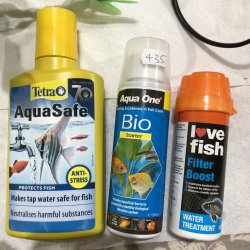Sorry for a long post.
My opinions of many additives sold to hobbyists is pretty low. Most of them are trying to make up for something biological/chemical that is likely absent or overly present in one's tank. Often there is a better, more natural and usually less expensive solution.
Next, there is a list of products I could make which do not really help with anything, even what they are supposed to according to the wording on the label. And many of us buy these. Because we do, everybody in the field has to make their own version. How many different Ich meds can we buy for example?
So what it all boils down to is what is the science behind it all? When talking about bacteria there is an abundance of science. But it is also important that we understand how the scientific method works. One has a theory about how something works. To determine if that theory is accurate or completely off the mark they design a research experiment to test out the theory. The design uses a pretty rigorous set of rules to help insure results are real and not the result of something unknown.
But the two most important facets of such research are as follows. If the research produces a result, other researchers should be able to replicate it. If doing the exact same thing yields different results each time, then clearly it is proof that the theory is not valid. However, science knows it is not perfect and future discovereies may invalidate the results of earlier experiments. This means very little is written in stone for all time.
And this applies to a lot of what we do in the hobby, especially cycling. Prior to 1996 it was believed that hte bacteria in our tanks which handle cycling issues were the same ones that did this in waste water treatment facilities. That was until Dr. Timothy Hovanec chose to research this for his Ph.D. thesis. What he discovered was the expected strains of bacteria were not there. And this led to two ensuing research papers which identified both the specific nitrite and then ammonia oxidizing bacteria found in tanks. It also lead to patents of the nitrite ones (it is more involved than just the bacteria themselves).
Dr. H. did all this while working as the:
Chief Science Officer, Aquaria Inc. Moorpark. CA. Aquaria Inc. is the parent company of Marineland Aquarium Products (consumer products), Marineland Commercial Aquariums (grocery stores/restaurants) Marineland Retailer Systems (fish display/sales units), Aquarium Systems Inc. (Instant Ocean sea salts) and Perfecto Manufacturing (Aquaria and stands). Responsible for the development of a research facility dedicated to the investigation of the biological, chemical and microbiological processes in closed aquatic systems such as tropical fish aquaria and life-support systems for the holding of seafood.
from
http://web.archive.org/web/20050307102048/http://www.marineland.com/drtims_Currvitae.asp
This is why Dr. Tim's One and Only and Tetra SafeStart contain the strains of live bacteria that end up in tanks once the cycle has been fully established.
This is also why we can seed new tanks with living bacteria from our other tanks, if we have them, of from other peoples cycled tanks. There are two two major difference between using products like Dr. Tim's/Tetra's and taking something from an existing tank. The products are created in a lab type setting and should be free of any nasties. However, when we take things from an established tank, whether one of our own or one from somebody else, any nasties in that tank will be coming along too.
Next, when one buys either of the two above mentioned bacterial starter products they will stat how many gallons of water the amount of bacteria should get almost fully cycled in a very short time (a week to 10 days). One can add the starter, wait a day and add fish gradually or wait until the tank is processing about 2.5 ppm of ammonia overnight and then stock the tank fully as you can with a tradition, unseeded, fishless cycle. But if we seed by adding things from an established cycled tank we have no idea how much bacteria we nay be adding. So there is no way to know how long the cycle will take.
The key when trying to seed any tank to accelerate the cycle is to start with the right live bacteria and then to give it what it needs. Too little or too much will create problems.
And now for a monkey wrench thrown into what we thought we knew about cycling. In 2006 under a rock in a pun;ic SW aquarium science discovered that another microorganism, an Archaea, prosessed ammonia to nitrite the same way the bacteria do. They also reproduced by dividing. They have since been found in other environments-soil and FW. They are found in big numbers in the oceans. They are also found fish tanks. Some tanks will have a lot, some tanks will have a fe and some tanks will have none. It seems to depend a lot on the sources of the water. The most obvious thing about the Archaea is that they can thrive on even lower levels of ammonia than can the bacteria.
Archaea constitute a domain of single-celled organisms. These microorganisms lack cell nuclei and are therefore prokaryotes. Archaea were initially classified as bacteria, receiving the name archaebacteria, but this term has fallen out of use. Archaeal cells have unique properties separating them from the other two domains, Bacteria and Eukaryota.
As I wrote above, science can discover new things which cause older things to be revised or even discarded. However, we can only work with the best info we have at the time. Would you believe that it has also been discovered that Nitrospira (the nitrite oxidizing bacteria in tanks) are actually able to process ammonia directly to nitrate. This would partially explain why the ammonia ones were only found to make up about 2% of all the bacteria in a tank.


